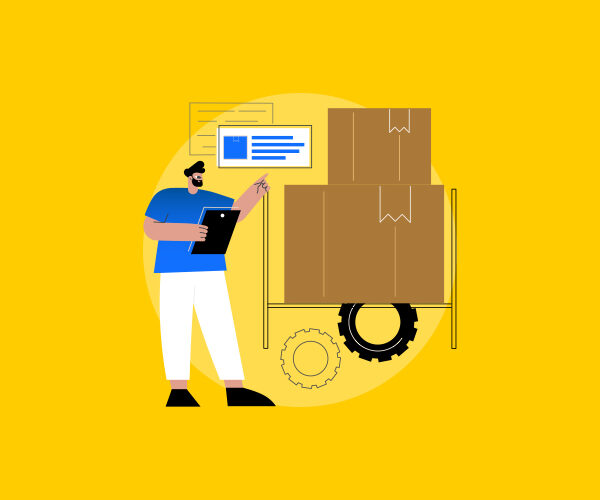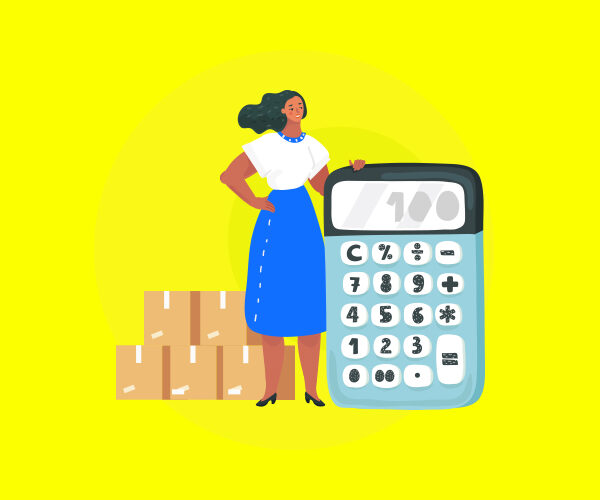When did you last love a brand because they happily accepted your returned product?
Waitt, I think I know the answer.
We all love brands that are transparent about their return policies, and the cherry on top is when their return process is as smooth as melted butter.
With the rise in e-commerce, returns are also on the rise. People buying online are less aware of the original form of the product, or the product might be faulty, damaged, or, in most cases, customers just don’t like that product and want to return it. The process involved here is known as “reverse logistics.” It’s a reverse engineering of a traditional, normal supply chain. This process involves the opposite movement of the product, from the end consumer to the distributor and then to the manufacturer. The smoother this process is, the greater its impact on brand reputation, sustainability, and customer relationships. According to the National Retail Federation (NRF) and Happy Returns, the average return rate in e-commerce was 16.9% in 2024, which is worth approximately $890 billion in total value.
What’s more concerning is that about 52% of online shoppers comprise Gen Z, and according to reports, about half of the Gen Z involved in online shopping return their orders. With this large percentage of people involved in returning (due to any possible reason), serious consideration is needed.
Businesses have started addressing this by building teams to manage their reverse logistics departments.
Now, let’s see what reverse logistics is and how businesses can save revenue, follow a sustainable approach, and prevent a large chunk of revenue could going to waste on returns.
What is reverse logistics?
Reverse logistics is the process that involves a reverse supply chain mechanism, where the end consumer returns the product to the brand/distributor, from where it goes back to the manufacturer.
Reverse products might get resold, refurbished, or remanufactured based on their condition to prevent waste and to follow a more sustainable approach to manufacturing. Due to this very reason, businesses are more involved in a circular economy to prevent any waste related to material, product, or manufacturing. According to Gartner, approximately 70% of businesses plan to invest in the circular economy.
With the rising demand, the reverse logistics industry is also growing. This is not only because it can prevent waste but also because it can save a good % of your product’s original value. According to the Council of Supply Chain Management Professionals (CSCMP), reverse logistics can recover up to 30% of the original product value through repairs, refurbishing, or recycling.
In the infographic below, you can see its growth over the years.
Reverse logistics in supply chain management
Reverse logistics is an important process within supply chain management that focuses on getting products back from customers, especially goods that are unsold or returned. This closed-loop supply chain helps companies minimize waste and cut down on costs, making it a win-win for both the business and the environment.
For instance, when a customer returns an item, instead of just throwing it away, reverse logistics helps the company figure out what to do with that product. They can either restock it to sell again, refurbish it to make it as good as new, or responsibly dispose of it if it can’t be reused. This not only keeps inventory organized but also supports the company’s goals of being more sustainable.
For wholesalers, this efficiency is very important. Quick processing of returned items means they can keep accurate inventory records, which helps prevent losses and improves overall inventory management. Plus, by focusing on sustainability, companies meet environmental regulations and work towards reducing their carbon footprint.
Types of reverse logistics
If you think that a customer asking for a return is the only type of reverse logistics, you need a table. Here it is. Several types fall under reverse logistics.
| Type | Purpose | Example | Impact/Stat |
| 1. Returns Management | Handle customer returns. | Amazon’s “no-questions-asked” return policy. | 30% of e-commerce orders are returned; streamlined returns cut costs by 15%. |
| 2. Remanufacturing/Refurbishing | Restore used products to like-new condition. | Apple’s iPhone trade-in program. | Refurbished electronics market to hit $167B by 2027. |
| 3. Recycling | Recover materials from unusable products. | Dell’s closed-loop recycling for server parts. | 85% of companies now prioritize recycling to meet ESG goals. |
| 4. Recalls | Retrieve defective or unsafe products. | Toyota’s hybrid battery recall (2024). | Auto recalls cost $30B/year; reverse logistics reduces liability by 40%. |
| 5. Repackaging | Restock returned items in sellable condition. | Walmart’s in-store return-to-shelf system. | 60% of unopened returns are repackaged, saving
8–12 per item. |
| 6. Liquidation | Sell returned goods in bulk to third parties. | Amazon Liquidation Auctions (pallet sales). | Liquidation recovers 20–40% of product value vs. 0% for landfill. |
| 7. Donation | Redirect unsellable goods to charities. | H&M’s garment donation program. | Tax breaks for donations offset 15–25% of losses. |
| 8. End-of-Life Disposal | Safely dispose of hazardous/non-recyclable items. | Best Buy’s e-waste recycling centers. | 53M metric tons of e-waste were generated globally in 2024. |
5-step reverse logistics process
The reverse logistics process comprises 5 simple steps;
1- Starting a return process:
The first step is when the customer initiates the return process online or via customer support. Reports show that after introducing a 1-click return policy, Amazon has improved its annual sales by 5%, which makes approx $2.4 billion in additional revenue.
2- Looking for a proper way:
The second step involves whether the customer needs to return the product by visiting the store, shipping it back to the warehouse, or if there is any specific additional clause in the return policy of that brand. Like Kohl’s offers its custom “Kohl’s drop off.” It’s their unique return process where a customer is given a QR code that they can scan at the local Kohl’s store to simply return the product – no complex cycle and dozens of follow-ups involved.
3- Receiving and inspecting the product:
Once the store receives the product, it moves it into its reverse logistics department, where the returned item is checked for damage, functionality, and resale potential. Based on that, it moves further in the return process.
4- Check for disposition:
Once inspected, depending on the condition, the item is restocked, refurbished, recycled, or discarded. If the product is in good condition and in demand, the brand will simply resell it as new or return it; if the product is damaged, it will be refurbished or recycled, depending on the product type. For example, Nestle makes its packaging reusable, while brands that deal in automobile parts can recycle or refurbish old ones to create new items.
5- Reintegration or disposal:
In the final step, when the disposition decision is made, the products are reintegrated into inventory or sent for responsible recycling or waste management.
Reverse logistics in e-commerce
E-commerce has dramatically changed how we shop online, especially when it comes to product returns. Invest research indicates that about 30% of products purchased online are sent back, while only 8.9% are returned in traditional brick-and-mortar stores (Retail). This means that a lot of people who buy things online don’t always keep them!
Your customers want an easy and free way to return items – that makes handling returns smoothly a major priority for businesses.
For wholesalers who sell to online retailers or run their own online stores, managing these returns efficiently is super important. They need to have systems in place that make return authorizations automatic, process refunds quickly, and keep inventory records updated in real-time. This helps them keep customers happy and stay competitive in the busy e-commerce market.
With a warehouse management tool, manage your reverse logistics
Managing a large number of returns can feel overwhelming, but the right tools can make it easier. Many warehouse management tools are available that help e-commerce, retail, and wholesale businesses effectively manage returns without delays or damage. A fast and error-free return process not only builds brand reputation but also customer relationships and increases sales and Customer Lifetime Value (CLV).
If you want to simplify your process by not delaying small tasks like processing return invoices, invest in a warehouse management tool and save time and effort that can be used elsewhere to build your brand in many ways.
Conclusion
Just like a smooth supply chain that fulfills customer needs, the reverse supply chain is equally important. With all the sustainable practices on the market, businesses are becoming increasingly aware of how to save the planet, reduce waste that can be used again, and build a sustainable customer community. By understanding what reverse logistics is and how it can impact the overall supply chain process, you can save tons of dollars and generate additional revenue.
I am ending this blog with a question for you: Is your business doing enough to save this planet? If you are confused, start with a sustainable reverse logistics process.
FAQs
What is reverse logistics?
Reverse logistics is the process that involves a reverse supply chain mechanism, where the end consumer returns the product to the brand/distributor, from where it goes back to the manufacturer.
What is the reverse logistics process?
The reverse logistics process comprises 5 simple steps;
1- The first step is when the customer initiates the return process online or via customer support.
2- The second step involves whether the customer needs to return the product by visiting the store, shipping it back to the warehouse, or if there is any specific additional clause in the return policy of that brand.
3- Once the store receives the product, it moves it into their reverse logistics department, where the returned item is checked for damage, functionality, and resale potential.
4- Once inspected, depending on the condition, the item is restocked, refurbished, recycled, or discarded.
5- In the final step, when the disposition decision is made, the products are reintegrated into inventory or sent for responsible recycling or waste management.
How much does a reverse logistics plan cost?
The cost may vary depending on the type of product you deal in. In general, an average cost of $10 -$40 is associated with processing a return. Some reports also suggest that reverse logistics can cost 7-11% of the total cost of goods available in the company.
What is design for reverse logistics (DFRL)?
It’s a practice that ensures the reverse logistics process is smooth and cost-effective. For example, companies use recyclable materials that they can reuse.






